-Stage 5.3-
Geology Through The Radio
Where popular music is used to help explain geological concepts.

As I was sitting and listening to the radio one day, a song captured my attention as containing some interesting geological concepts, Horse With No Name by America. So I figure I would do like I have done for literature and make a creative exercise based on this. And we will see to how far this expands.
Available Geology Reviews
America's "A Horse with No Name"
While many songs have the possibility to be examined in a geological sense, there are few as blatant with their geological references as Elton John's "Honky Cat"
Geology
While not pervasively throughout the song, there is one line that pops up a couple of times: "It's like trying to find gold in a silver mine". While this might seem like a simple phrase because who would go looking for gold in a silver mine, the formation of gold and silver deposits are linked and they are actually found together quite frequently. In many silver mines, gold typically accounts for 0.5-5% of production because gold and silver veins (along with many other precious metals) are produced from the cycling of hydrothermal waters surrounding a volcano.
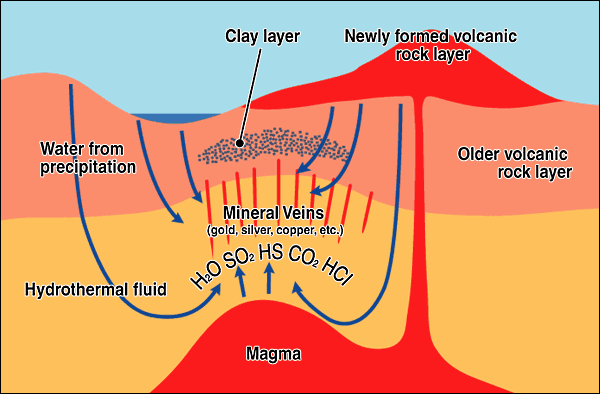
Mineral vein creation from hydrothermal fluids. Image courtesy of web-japan.org.
Magma's have all sorts of dissolved elements and minerals in them. As the magmas heat up the surrounding countryside near a volcanic source (or potential volcano) also heats up. This includes the groundwater, producing hydrothermal fluids that becomes enriched in the minerals from the magma as well as minerals from the surrounding rock. As these fluid travel through cracks and fissures of the much cooler rocks further away from the magma, the fluids cool down and mineral deposits are precipitated.
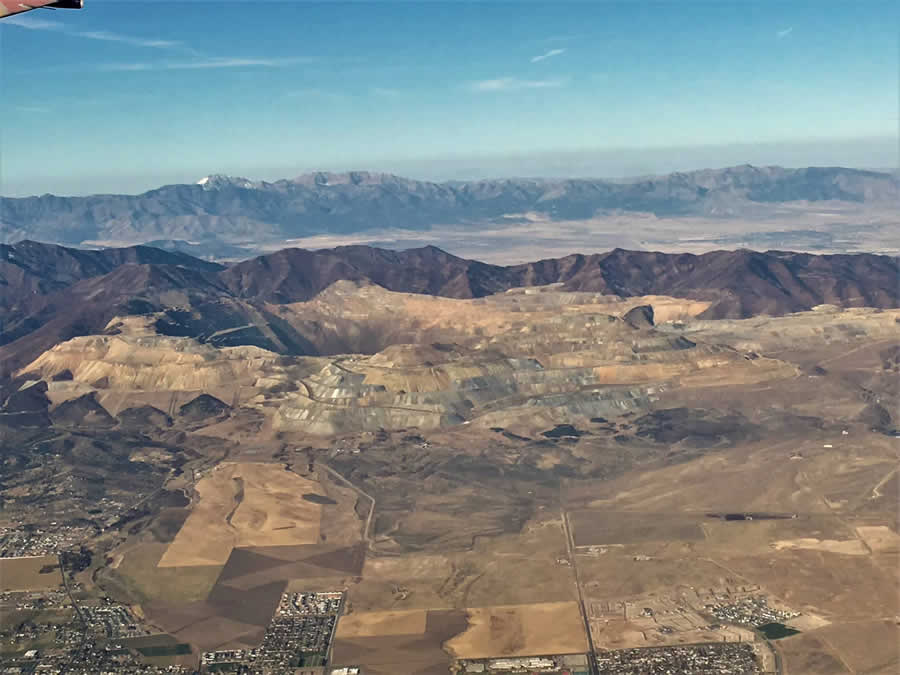
View of the Bingham Canyon Mine facing west
The presence of these precious metals also indicates something else about the environment. Even if there is no volcanic activity at the moment in these areas, it means that there was once volcanic activity there. Utah's Bingham Copper Mine is a perfect example, where there is clearly no volcanic activity anywhere currently near the mine, however, at one point in the past there must have been, because of the deposition of not only a large abundance of copper, but also silver and gold within the mine.
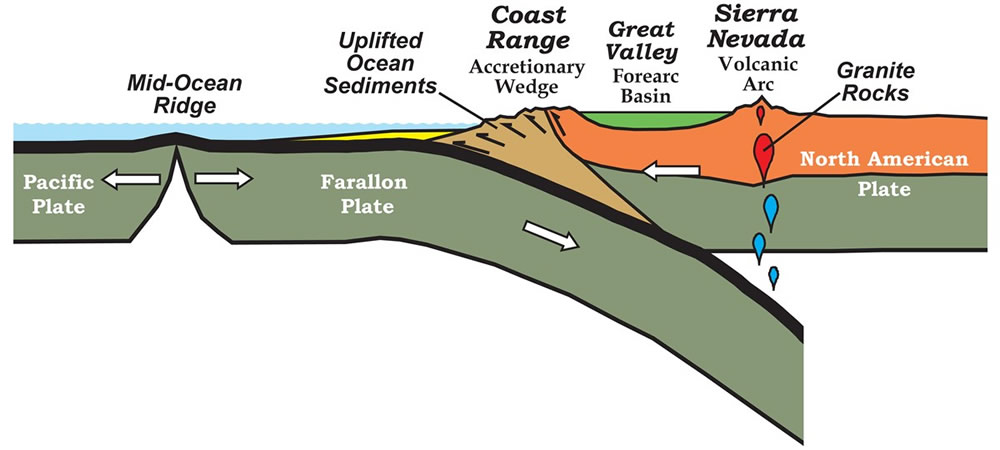
Diagram of the Farallon Plate subduction zone along the western United States. Image courtesy of the NPS.
I go into more detail on the Bingham Copper mine HERE, however a short version of it is that at one time there was a subduction zone along the western coast of North America that produced volcanoes across the western US. Around 30 to 40 million years ago, that line of volcanoes was located within Utah. Magma was slowly injected into the Oquirrh Mountains, predominantly into the 300 to 350 million years old rock formation known as the Oquirrh Group. These rocks, laid down in the Carboniferous (i.e. the Pennsylvanian and the Mississippian), are composed mostly of quartzites and limestone beds. This magma body slowly cooled to form what is known as the Bingham Stock, an igneous body identified as a monzonite porphyry. In addition to the magma body itself, is that the hot magma produces a lot of hydrothermal fluids within proximity of the magma body. These hydrothermal fluids move the heavy metals (such as gold, copper, silver, etc.) from within the magma and redeposit them within the surrounding landscape.
So, the Utah version of this is "It's like trying to find gold in a copper mine"
Although, likely played as a joke, here is Brad Paisley's country song named "Geology" from the never released album - Your Substrata Makes My Lava Flow.
I love the geology background that is given for Tennessee in the song. Here are the lyrics:
Way back in the distant past,
500 million years or greater.
Tennessee was a tectonic plate,
Under the ocean, near the equator.
And a few million years the plates began,
A steady northern migration.
Volcanoes blew, and the earth arose to,
Form the Appalachians.
The range of mountains began to form,
400 million years ago.
And sandstone formation came along,
on the Cumberland Plateau.
The Paleozoic and the Mesozoic,
built the hills just like a mesa.
In the Cenozoic era,
appeared the Nashville basin.
Beneath the limestone, sandstone, and shale,
The Earth moved as it must.
And form the Blue Ridge Mountains,
By sub-horizontal thrust.
Here on plutonic igneous rocks
On a Precambrian promontory.
That is where I first met you,
Which is a whole other story.
Geology, geology.
That’s how God made Tennessee.
And Tennessee is where I found a girl,
Whose feet are on the ground.
Whose substrata make the lava flow,
And that is all you need to know.
One day I was listening to the radio and it a appeared that a geologically themed song was playing. Little did I realize when I first heard it, that the song title, "Pompeii" by Bastille, was also geologically themed. After that I proceeded to listen to the lyrics a bit more closely, I realized that not only was the song named after a geological event, it actually was completely about that said event (not some fancy title that has nothing to do with the song what-so-ever).
I was left to my own devi-i-i-i-ces
Many days fell away with nothing to show
And the walls kept tumbling down
In the city that we love
Gray clouds roll over the hills
Bringing darkness from above
But if you close your eyes,
Does it almost feel like
Nothing changed at all?
And if you close your eyes,
Does it almost feel like
You've been here before?
How am I gonna be an optimist about this?
How am I gonna be an optimist about this?
We were caught up and lost in all of our vices
In your pose as the dust settled around us
And the walls kept tumbling down
In the city that we love
Gray clouds roll over the hills
Bringing darkness from above
But if you close your eyes,
Does it almost feel like
Nothing changed at all?
And if you close your eyes,
Does it almost feel like
You've been here before?
How am I gonna be an optimist about this?
How am I gonna be an optimist about this?
Oh where do we begin?
The rubble or our sins?
Oh oh where do we begin?
The rubble or our sins?
And the walls kept tumbling down (oh where do we begin?)
In the city that we love (the rubble or our sins?)
Gray clouds roll over the hills (oh where do we begin?)
Bringing darkness from above (the rubble or our sins?)
But if you close your eyes,
Does it almost feel like
Nothing changed at all?
And if you close your eyes,
Does it almost feel like
You've been here before?
How am I gonna be an optimist about this?
How am I gonna be an optimist about this?
If you close your eyes, does it almost feel like nothing changed at all?
The Geology
I found this song a perfect example of geology on the radio because they decided to title the song simple "Pompeii", which is a reference I am assuming a lot of people would get. For those who don't know, the song talks about the eruption of Mount Vesuvius back in 79 CE (Common Era), which destroyed the town of Pompeii. Along with Pompeii, the lesser known town of Herculaneum was also destroyed in the same eruption. The towns were destroyed during the release of volcanic ash, gas, pyroclastic debris, and eventually in what is called a pyroclastic flow.
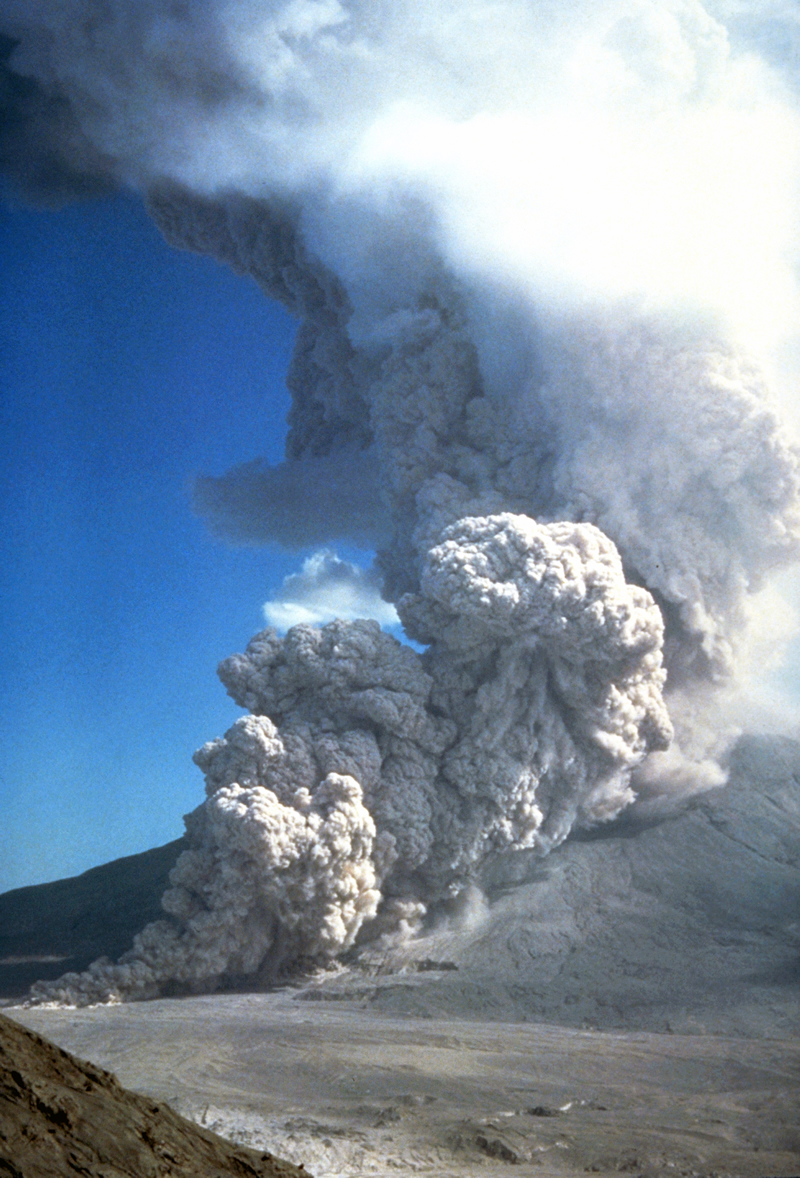
A pyroclastic flow off the side of Mount St. Helens, May 18, 1980. Image courtesy of the the USGS.
A pyroclastic flow is a super heated (>400 degrees C) ball of gas, ash, and rock that flows down the side of a volcano at tremendous speed (~100 km/hr). It is estimated that the ~2,000 victims of the eruptions found at Pompeii were killed within 15 minutes of the eruption (The Guardian).
In an interview about the song, the band's frontrunner Dan Smith (RadioX) said that:
"I was reading a book that had some picture of the people who got caught up in the volcanic eruption. And it's just such a kind of dark powerful image, and it got me thinking about how boring it must have been emotionally after the event. To be sort of stuck in that same position for hundreds and hundreds of years. So, the song is sort of an imaginary conversation between these two people who are stuck next to each other in their sort of tragic death pose".
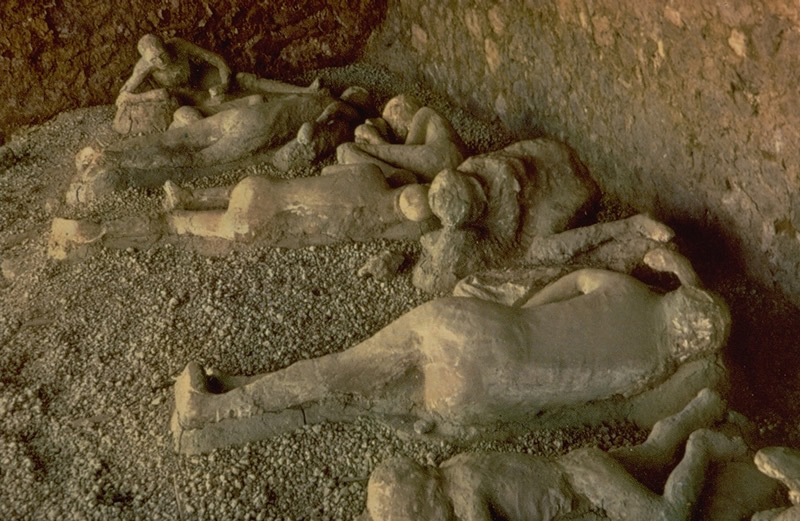
Cast of some of the victim's bodies at Pompeii. Image courtesy of the Global Volcanism Program.
The victims of the eruption likely died in a multiple of ways. The first wave of deaths took place from the raining cloud of rocks from the initial eruption that Mt. Vesuvius ejected into the air. These rocks have been shown to have caused head traumas to many of the victims (The Atlantic). More deaths occurred from the suffocating ash and toxic gasses, and then eventually the pyroclastic flow. The ash adhered to the bodies of the victims, essentially cocooning them in a hardened shell of rock. Over the centuries the bodies decayed, leaving behind voids in the rock. It is these voids that archaeologists eventually realized formed something, so they filled them with plaster, only to discover that they were the remains of the victims. Unlike most of the organic material which decayed away, many of the bones also remained within the voids left behind in the ash.
There are few “popular” songs that talk about geological events. One of those is Volcano by Jimmy Buffet which talks about a volcanic eruption. Here are some questions using the song lyrics to understand volcanoes and if what he is talking about is possible.
1. “Ground she’s movin under me” refers to what? (Specifically harmonic or tectonic in this instance)
2. What is the typical source of “tidal waves” and is the scenario so far conducive to tidal wave production?
3. Based on the clues in the song, what is the environment (and what are those environmental indicators)?
4. What kind of volcanoes would you expect in this type of environment?
5. Would you expect “sulphur smoke” and “soft and hot” lava from this type of volcano?
6. Would this type of volcano “blow”? Enough to launch people into space (metaphorically speaking)?
7. Why would you see your “skin aglow” at Three Mile Island?
Click below for the Jimmy Buffett's Volcano directions in pdf format
Jimmy Buffett's Volcano Directions
Answers can be obtained by directly emailing me at Jazinator@hotmail.com
America’s "A Horse With No Name"
America's "A Horse With No Name" is one of my favorite examples of Geology Through the Radio, because it isn't what you would expect.
A Horse with No Name
On the first part of the journey
I was looking at all the life
There were plants and birds and rocks and things
There was sand and hills and rings
The first thing I met was a fly with a buzz
And the sky with no clouds
The heat was hot and the ground was dry
But the air was full of sound
I've been through the desert on a horse with no name
It felt good to be out of the rain
In the desert you can't remember your name
'Cause there ain't no one for to give you no pain
La la la la la la...
After two days in the desert sun
My skin began to turn red
And after three days in the desert fun
I was looking at a river bed
And the story it told of a river that flowed
Made me sad to think it was dead
You see I've been through the desert on a horse with no name
It felt good to be out of the rain
In the desert you can't remember your name
'Cause there ain't no one for to give you no pain
La la la la la la...
After nine days I let the horse run free
'Cause the desert had turned to sea
There were plants and birds and rocks and things
There was sand and hills and rings
The ocean is a desert with its life underground
And a perfect disguise above
Under the cities lies a heart made of ground
But the humans will give no love
You see I've been through the desert on a horse with no name
It felt good to be out of the rain
In the desert you can't remember your name
'Cause there ain't no one for to give you no pain
La la la la la la...
Geology
While not explicitly "geological", I have always found the lyrics in "A Horse With No Name" to be reminiscent of a major geological event. When looked at the course of the song, the rider starts off in the desert, however by the ninth day "the desert had turned to [the] sea". When a land surface that is subaerial eventually gets covered over with the ocean, this is known as a transgressive sequence.

Transgressive sequence. Image courtesy of SEPM.
As you can see in Figure 1 above, the desert/beach in Image A is eventually overrun by the ocean/sea in Image B. There are two possible methods for this to happen. One is that the land surface could be slowly sinking in relation to sea level. This can actually be witnessed today in areas along the coasts where the weight of the sediment, or even buildings, slowly lowers the surface elevation, such is in the case of New York City or Venice. The other is that sea level is rising in relation to the land surface. This can also be witness today with the continued melting of the polar glaciers due to climate change and a quickly warming planet, this melting ice can be seen to raise sea level over time. There is also a third possibility, which is a combination of the two events occurring.
As the sea level rises in relation to the land and inundates the surface, eventually the sediment that is deposited will change. As we can see in Figure 1 above and Figure 2 below, the surface sediment for a desert or a beach would typically be sand. Once the land is inundated, that sand would shift to clay or mud as the water levels progressively got deeper and further away from the shoreline. Eventually the water would be deep enough with the shoreline far enough away that most sand and mud/clay would get deposited closer to shore, leaving only the deposits from the dead animal life as it built up over time. These dead organisms, formed mostly from calcite shells, would be compacted and lithified (turned into a rock), over time. These rocks are mostly a variety of limestone, which is identified by the blue brick pattern seen in the figures above and below.
Figure 2: A simplified example of a transgressive sequence in the rock record.
This pattern can also be seen in the rock record. If we were to see the rocks sitting on the side of the road, what is known as an outcrop (Figure 2), they would generally have the pattern of sandstone on the bottom representing the beach or desert. Siltstone above that, which is a smaller sediment size typical of the just offshore environment. Then mudstone or shale, a rock typically of fine layers of clay sized particles that is even further off shore. So in this instance as the water level deepens, the shoreline is shifting away from this location. And finally on top is the limestone, where we have reached a far enough distance from the shore that particle sediment (like sand and mud) is limited.
There is one major point of interest between a real life transgressive sequence and the song, and that is a matter of time scale. A true transgressive sequence like this would typically take hundreds of thousands to millions of years to fully inundate a desert like environment, however in the song it only takes nine days. So, while it is a cool comparison to a real life geological event, it does need to be taken with a grain of salt.
Possible Educational Questions to Ask
-
What are the environments mentioned in the song?
-
What types of conditions does the song use to define these environments?
-
Does this match what is geologically used to define the environments?
-
What did the singer of the song find on the 3rd day, and do you think you could see this feature in the desert?
-
What is the geological term for the change in environment described in the song (“desert had turned to the sea”)
-
What are the two (tectonic) possibilities to explain how this could happen?
-
The song states that “after 9 days…the desert had turned to sea”. Assuming a really fast time period for this to happen is 100,000 yrs. How much faster is this event that the band America described in the song?
-
“The ocean is a desert with its life underground”. Now assuming they meant underwater, do you agree with this statement? Why or why not?
